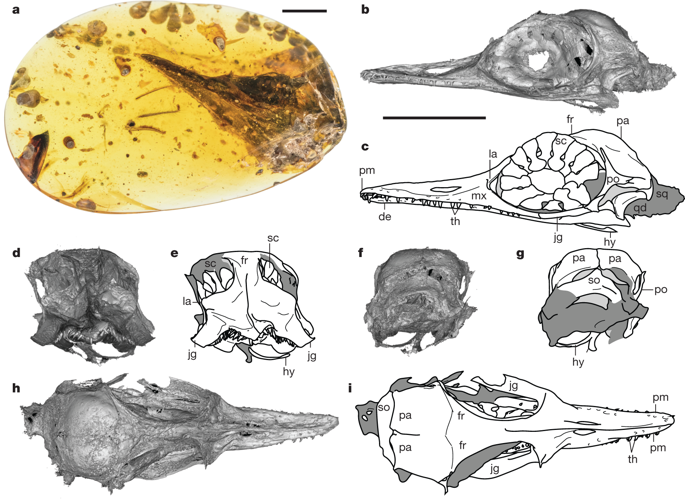Nature ( IF 50.5 ) Pub Date : 2020-03-11 , DOI: 10.1038/s41586-020-2068-4 Lida Xing 1, 2 , Jingmai K O'Connor 3, 4 , Lars Schmitz 5, 6 , Luis M Chiappe 5 , Ryan C McKellar 7, 8 , Qiru Yi 9 , Gang Li 9, 10

|
Skeletal inclusions in approximately 99-million-year-old amber from northern Myanmar provide unprecedented insights into the soft tissue and skeletal anatomy of minute fauna, which are not typically preserved in other depositional environments1,2,3. Among a diversity of vertebrates, seven specimens that preserve the skeletal remains of enantiornithine birds have previously been described1,4,5,6,7,8, all of which (including at least one seemingly mature specimen) are smaller than specimens recovered from lithic materials. Here we describe an exceptionally well-preserved and diminutive bird-like skull that documents a new species, which we name Oculudentavis khaungraae gen. et sp. nov. The find appears to represent the smallest known dinosaur of the Mesozoic era, rivalling the bee hummingbird (Mellisuga helenae)—the smallest living bird—in size. The O. khaungraae specimen preserves features that hint at miniaturization constraints, including a unique pattern of cranial fusion and an autapomorphic ocular morphology9 that resembles the eyes of lizards. The conically arranged scleral ossicles define a small pupil, indicative of diurnal activity. Miniaturization most commonly arises in isolated environments, and the diminutive size of Oculudentavis is therefore consistent with previous suggestions that this amber formed on an island within the Trans-Tethyan arc10. The size and morphology of this species suggest a previously unknown bauplan, and a previously undetected ecology. This discovery highlights the potential of amber deposits to reveal the lowest limits of vertebrate body size.
中文翻译:

缅甸白垩纪蜂鸟大小的恐龙
缅甸北部约 9900 万年前琥珀中的骨骼内含物提供了对微小动物群的软组织和骨骼解剖学的前所未有的见解,这些动物群通常不会在其他沉积环境中保存1,2,3。在多种脊椎动物中,以前曾描述过七种保存对映鸟骨骼遗骸的标本1,4,5,6,7,8,所有这些标本(包括至少一个看似成熟的标本)都小于从石质材料。在这里,我们描述了一个保存异常完好的小型鸟类头骨,它记录了一个新物种,我们将其命名为Oculudentavis khaungraae将军 等人。十一月 这一发现似乎代表了中生代已知最小的恐龙,其大小可与蜂鸟(Mellisuga helenae)——最小的现存鸟类——相媲美。O. khaungraae标本保留了暗示小型化限制的特征,包括独特的颅骨融合模式和类似于蜥蜴眼睛的自变形眼部形态9 。圆锥形排列的巩膜听小骨定义了一个小瞳孔,表示昼夜活动。小型化最常出现在孤立的环境中,因此Oculudentavis的小型尺寸与先前的建议一致,即这种琥珀形成于 Trans-Tethyan arc 10内的一个岛上. 该物种的大小和形态表明以前未知的 bauplan 和以前未被发现的生态。这一发现突出了琥珀矿床揭示脊椎动物体型最小极限的潜力。











































 京公网安备 11010802027423号
京公网安备 11010802027423号